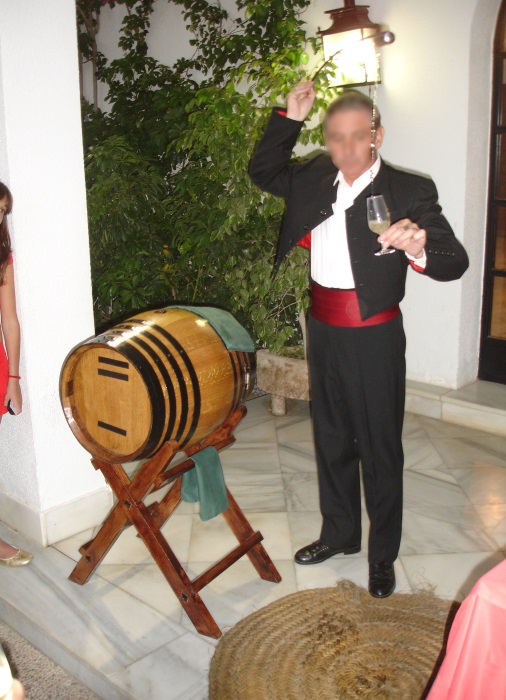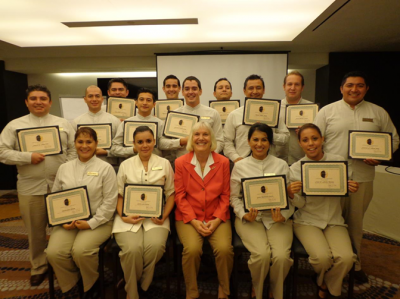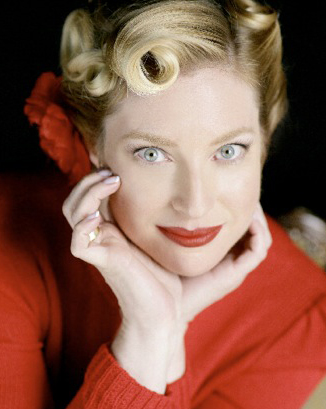
The Modern Butlers’ Journal volume 9, issue 12
International Institute of Modern Butlers
 Message from the Chairman
Message from the Chairman
2013 has been rather busy in the private sector, but we were still able to fit in some assignments at a few resorts, two of which are noted in this issue. We are often asked what it is like to train in such places–so in response, we offer this short video.
This issue marks a rather special occasion for the Institute: the conclusion of the first decade of publication of the Modern Butlers’ Journal.
So much has come and gone for those in our profession during those ten years—alliances made and ended, jobs found and lost and found again, programs or initiatives started, waylaid, and completed. In the bigger picture, we have borne witness to a rebounding demand around the world for the profession, as the newly wealthy search for a proper vehicle to manage their properties and staffs.
Wherever we will all be at the close of 2023, the real question will be, “Did we enjoy, and are we proud of what we accomplished in, the journey?”
We hope your journey is as scintillating as it is productive.
On an administrative note, the emailed alert that the monthly MBJ has been posted will no longer be sent out as a courtesy by the Institute after this December issue—so if you wish to keep receiving it and have not already done so, please subscribe at the top right.
Butlers in the Media
“If a machine takes your job, become a butler,” is the title of an intriguing article in Bloomberg News that points out that butlers are faring rather well servicing those who are benefitting from a world economy that is not being too kind to the majority.
Perceptions of the Butler (Part 2 of 5)
by GJ dePillis
The interviews of potential employers were conducted conversationally, so the interviewee felt comfortable about being honest with their reply. The first set of inquiries focused on the ideal butler applicant.
AGE: What should be the ideal age of an applicant for the position of butler?
51% of those interviewed felt the ideal age for their butler was between 30 and 40. 33% said their butler should be over 40 years old. 16% said they would only consider a candidate who was over 50.
SCHOOLING: Should the candidate have completed formal butler training, or should the candidate have received training in an established household, having started at an entry level position and worked his way up?
50% preferred candidates who had received formal butler training. When asked why, the general response was that they didn’t want to entertain a candidate who had learned bad habits in another household and therefore, they wanted optimal formal training. 33% said they preferred somebody who had risen to the position of butler in an established household, because there is no replacement for work experience. 17% stated they would consider candidates with both sorts of training.
Is it important for your candidate to have a four-year college degree?
80% stated that a college degree was not a factor in their hiring decision for a butler. 20% stated they did prefer a college degree, but the subject area did not matter. However, a personal assistant was expected to have at least a two-year college degree, since a personal assistant is expected to have computer knowledge and other corporate skills.
PERSONAL BELIEFS: Do the personal religious practices or political beliefs of a candidate influence the hiring decision of an employer?
84% said yes. They want to make sure their beliefs line up with whomever they employ. They felt that religious and political beliefs would make a strong impact in the management of the household. 16% stated they would judge their candidate on other issues. Religion and politics didn’t matter to them.
CHARACTER TRAITS: After engaging a butler, the following words (listed in the order of frequency) describe the disposition and character an employer expects from their butler:
Happy, honest, responsible, punctual, competent, dependable, discrete, and has a clean, crisp, formal appearance. In particular, several employers interviewed commented that they expect their butlers to wear a clean, white-collared shirt and dark blazer for every day and formal dress, as appropriate for the occasion. Only in warm weather conditions would a short-sleeved collared shirt and khaki pants be considered acceptable. In brief, employers are expecting a competent, cheerful, employee who does the job responsibly.
One interviewee was very particular in specifying that they expect their butler to be attentive without hovering. This individual valued a butler who was a good listener, yet possessed the maturity to know when to stop asking questions. In short, their butler is expected to engage in “conversation on demand”. The butler is not to pry nor ask personal details, but instead wait for the employer to offer such information. The employer stated they would be offended if the butler overstepped conversational boundaries and the butler is never to ask too many questions.
CANDIDATE SEARCH: Where would potential employers go to find qualified butler candidates?
54% said they would ask their friends. 28% said they would go to an established agency or hire a targeted headhunter. 18% stated they would do an internet search by using professional networking sites, such as LinkedIN, or place an ad themselves. The predominant method of finding a potential butler candidate appeared to vary with the lifestyle of the employer: Those who had made their fortunes in technology opted for the online professional networking options, such as LinkedIN. Those who entertained more, felt their personal networks were the most reliable. Those whose families employed staff for more than one generation, trusted an agency. Those who had built their staff team using a specific agency, said they would urge others to use their favorite agency.
FRIENDLY ADVICE: At what point would you recommend to a friend that they employ a butler? Almost all of the respondents stated that triggers for suggesting that friends should hire a butler were noticing a lack of time, being too busy, having too many demands to the point that they could not fulfill their obligations, being a bad organizer, or entertaining a lot at home.
Part 3 of our series will address further perceptions.
Ms. dePillis is a freelance contributor to the Journal, who is based on the West Coast of the United States. She can be reached via depillis at gmail.com
NB: The caricature image of the butler used in this article is © 2013 by John dePillis
Let’s Talk about Wine, Part XXI
by Amer Vargas
Fortified wines
Fortified wines result from adding a distilled beverage (also called a “spirit”) to wine during its production, in a process called “fortification.” Most commonly, the spirit used comes from grapes, although it can also come from grain, sugar beets, or sugarcane.
Fortification was originally thought of as a preservation method so wine would last longer, thus allowing it to be transported over distances, or to be stored for longer periods than normal for wine.
The spirit is added before the fermentation process or before the end of it, the spirit killing many of the yeasts and causing many sugars to go unfermented. Thus it results in more robust, stronger texture, and sweeter wines.
The addition of the spirit increases the level of alcohol in the wine: whilst regular wines do not generally surpass the 14.5% alcohol level (after which point the yeast is killed), fortified wines show an alcohol range of 15% to 25%. If a sweet fortified wine is desired, fortification takes place within the first day-day and half of the fermentation process; this stops the sugar consumption of yeasts and leaves more residual sugars in the wine, hence a sweeter taste. For drier versions, fermentation may be stopped towards fermentation’s end (sometimes right after its end) to ensure less sugars are left in the drink.
If aging is desired, it is done in wooden casks and may last from a few months to several years. Indeed, the longer the aging, the more complex the fortified wine will be and the more it will benefit from decanting and aeration.


The most famous fortified wines around the world are Sherry, Port, Madeira, Vin doux (naturels), Marsala, and Vermouth.
Sherry comes from the so-called “Sherry Triangle” in southwest Spain, where it is produced mainly with Palomino and Pedro Ximénez grapes. Depending on when the fortification is induced, sherries vary from Fino (driest), Manzanilla, Manzanilla Pasada, Amontillado, Oloroso, Dry, Pale Cream, Medium, Cream, Moscatel, Sweet and Pedro Ximenez (sweetest).
Port, originally coming from the Portuguese city of Porto in the Douro Valley, is a fortified wine that is typically red and sweet, although semi-dry and dry white varieties also exist. Port can be aged in wooden casks or in the bottle and can be divided into regular ports (Ruby and Tawny) and high quality ports (Late Bottled Vintage, Vintage, Single Quinta Vintage), or with the age identified when aged in wooden barrels for more than 10 years.
In the next article, we will talk more about fortified wines; in the meantime, enjoy the holiday season with an Amontillado wine to open your appetite, and a fine Port wine with cheese…great delicacies!

Cheers for a brilliant 2014!
Mr. Vargas can be contacted via AmerVargas at modernbutlers.com
Hospitality Training


Consulting the Silver Expert
by Jeffrey Herman
Q: Can scratches on silverplate be removed?
A: Unfortunately, scratches cannot be removed on silverplated objects – here’s why: Good quality silver is plated with 40 microns (.0015″) of fine silver. After plating, the object is given a final polish, which removes some of this silver. The piece will then be left with no more silver than the thickness of a plastic grocery bag. A scratch is generally deeper than the thickness of the silverplating, so only a quick polishing with a very fine polishing compound is possible in order to brighten the piece. Attempting to remove scratches will only cut through the plate and expose the base metal.
Mr. Herman continues to offer his services to our readers, for any questions you may have about the care of silver. Either call him at (800) 339-0417 (USA) or email jeff at hermansilver.com
The Institute is dedicated to raising service standards by broadly disseminating the mindset and skills of that time-honored, quintessential service provider, the British Butler, adapted to the needs of modern employers and guests in staffed homes, luxury hotels, resort, spas, retirement communities, jets, yachts, & cruise ships around the world.





